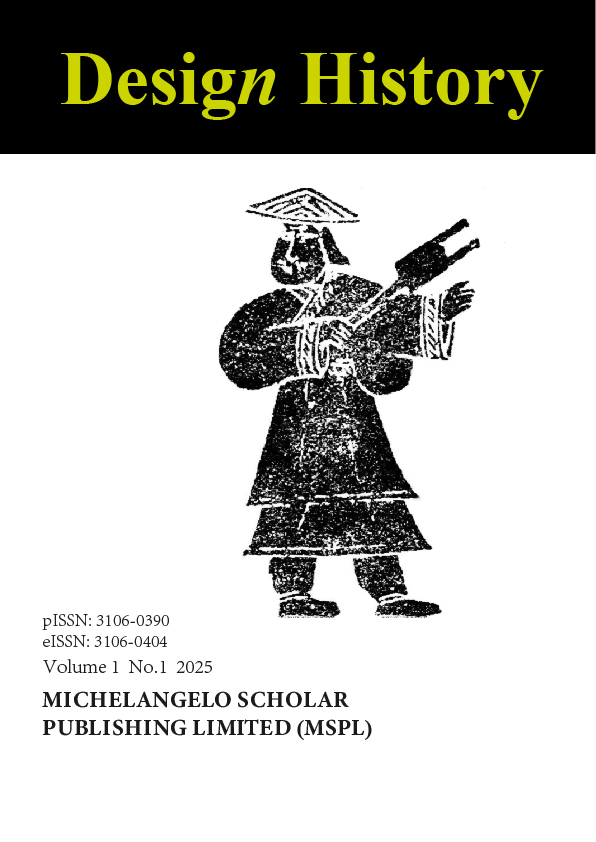Latest Articles
Understanding the Interdisciplinary Nature of DH
DH embraces the interdisciplinary nature of design service and social innovation, recognizing that effective solutions often emerge from the convergence of diverse perspectives and expertise. The journal welcomes contributions from various fields, including design, sociology, education, public health, engineering, and business, to foster a holistic understanding of social challenges and opportunities.
by
Min Wang *
1,by
Meng Liu *
See Instructions for Authors for manuscript requirements.
Submitting Your Manuscript: dh.editorialmanager04@gmail.com
or Submitting Your Manuscript to our online system: https://ojs.michelangelo-scholar.com/index.php/DH/submissions
October 15th, 2025
DH is an international scholarly journal that was registered in July 2025 and is dedicated to the publication of high-quality original design research (published semi-annually in print and online simultaneously). DH implements a double-blind peer review process and a no-fee open access policy (we do not charge any fees for either authors or readers), with a focus on design innovation issues in multidisciplinary fields for social services.
Thematic research articles, literature reviews, and book reviews are the three types of original articles accepted by the journal. Among the subjects addressed are design service and assessment, social innovation theory and practice, and design as a driving strategy for social and cultural construction. DH aims to share innovative design ideas and solutions, explore issues such as sustainable design and consumer services, and promote design for harmonious social development and multicultural exchange.
Call for Articles
Core Themes: Human factors, logic, and cultural History in the design practice
Design History is an International Journal that actively seeks high-quality submissions that advance scholarly understanding of design's historical dimensions. We welcome diverse methodological approaches, theoretical frameworks, and geographic perspectives that contribute to the evolving discourse in design history.
As an international platform for design historical scholarship, the journal serves as a bridge between academic research and professional practice, fostering dialogue across disciplinary boundaries. We are particularly interested in submissions that demonstrate innovative approaches to archival research, digital humanities methodologies, and interdisciplinary collaboration.
Research Article
We invite original research manuscripts (7,000-9,000 words) on all aspects of design history. Submissions should offer new insights, methodologies, or theoretical frameworks that advance understanding of design's historical dimensions.
Priority areas include decolonial approaches to design history, gender in design practice, environmental design histories, digital design cultures, and cross-cultural design exchanges. We particularly encourage submissions that challenge traditional narratives and introduce underrepresented voices to the field.
Strong research articles demonstrate rigorous archival work, theoretical sophistication, and clear relevance to contemporary design discourse. We welcome comparative studies, transnational analyses, and interdisciplinary approaches that draw on fields such as anthropology, sociology, and cultural studies.
Special Topic
Design History welcomes proposals for Special Topics addressing emergent themes, methodological innovations, or underexplored geographic contexts. Prospective guest editors should submit a 500-word concept statement and a potential contributor list.
Special Topics can explore topics such as design and decolonization, sustainable futures, and gender politics in design. We seek proposals that demonstrate scholarly rigor while addressing contemporary concerns relevant to the design history community.
Special Topics should include 6-8 research articles, an editorial introduction, and may incorporate alternative formats such as visual essays or interviews. Guest editors work closely with our editorial team to ensure coherence and quality across the issue.
Exhibition Review
Critical reviews (2,000-2,500 words) of significant design exhibitions are accepted on an ongoing basis. Reviews should contextualize exhibitions within broader currents in design historical scholarship and curatorial practice.
Strong reviews analyze curatorial decisions, assess the exhibition's contribution to public understanding of design history, and engage with the broader implications for the field. We encourage reviews of exhibitions from diverse global contexts.
Reviews should evaluate the exhibition's historical narrative, consider its pedagogical effectiveness, and address questions of accessibility and audience engagement. We particularly welcome reviews that examine how exhibitions contribute to ongoing debates in design history.
by
Zhewen Zhao *
PUBLISHED BY MICHELANGELO SCHOLAR PUBLISHING LIMITED
ADDRESS: ROOM A-2, 3/F, WING TAT COMMERCIAL BUILDING, 121-125 WING LOK STREET, SHEUNG WAN, HK
TEL: 00852-66761250
FAX: 00852-36197558; WHATSAPP: +60 11-2370 2845







